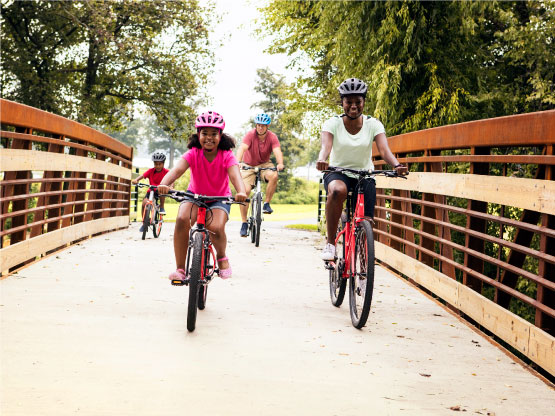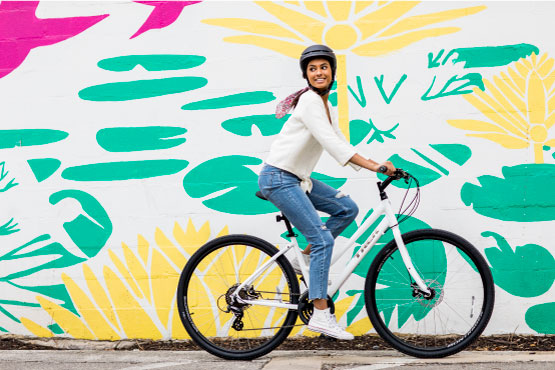
What size bike should I get?
We’ve compiled an extensive guide to bike sizing that makes figuring out the right size a whole lot easier. Below you’ll find great info on how different bikes are sized and how to find the best fit for men, women, and kids. Consulting a bike shop is always the best way to get the best fit, but this article will help you get a good idea of where you sit.
Read on for the full story or use the table of contents or navigation buttons to skip to specific sections.
How do you figure out your bike size?
Bike sizing can be a bit of a pain sometimes because there isn't always one universal system of measurement that’s the same for all types of bikes and all riders.
Depending on whether you’re looking for an adult bike, a kid’s bike, a road bike, or a mountain bike, you’ll need to find out what your frame size or wheel size is.
We always recommend heading into your local bike shop to get the best possible fit, but you can also you the size charts and information in this guide to find the size that's best for you.

Adult bike sizing vs kid bike sizing
In a nutshell, adult bikes are sized by the frame, and kids bikes are sized by the wheel.
That means that there are two completely different measurement systems between adult and kids bikes. As children grow they’ll obviously start to fit on small adult bikes, but generally, kids 12 and younger will fit on bikes that are measured by the size of the wheels.

Women’s bike sizing
While some companies offer women-specific models with designs that aim to incorporate better-fitting components, there is no substantial difference between men’s and women’s bike sizes. Both women and men can use the same adult bike size charts below to find a great fit.
Road bike sizing vs mountain bike sizing
To make matters a little more confusing, sizing can also vary between styles of bike or the company that makes them. For example, road bikes and mountain bikes will often use different numbers to designate sizes.
Without going into too much detail, bike size used to be determined by measuring specific parts of the bike, like the seat tube. However, over time manufacturers have decided to update their measurement system since bike geometries have changed considerably. The goal was actually to make it easier for people, but since some companies still stick with the old systems, it can be a bit puzzling.
Important Info About Bike Size Charts
In the sections below we have broken down a few size charts for road bikes, mountain bikes, hybrid bikes, and kids bikes. It’s important to note that there is no single bike size chart that is universal to all brands or styles. Many bike manufacturers differ slightly in their sizing, but the charts below will give you a good idea of where to start.
Road Bike Size Chart
Road bikes will often use measurements in centimeters to denote frame sizes. If you’re looking at a road bike and you don’t know what size it is, start by measuring the seat tube, as that will give you a good ballpark idea.
Size | Height | Inseam |
|---|---|---|
| 47 | 152.0 - 158.0 cm 4'11.8" - 5'2.2" | 71.0 - 75.0 cm 28.0" - 29.5" |
| 50 | 158.0 - 163.0 cm 5'2.2" - 5'4.2" | 74.0 - 77.0 cm 29.1" - 30.3" |
| 52 | 163.0 - 168.0 cm 5'4.2" - 5'6.1" | 76.0 - 79.0 cm 29.9" - 31.1" |
| 54 | 168.0 - 174.0 cm 5'6.1" - 5'8.5" | 78.0 - 82.0 cm 30.7" - 32.3" |
| 56 | 174.0 - 180.0 cm 5'8.5" - 5'10.9" | 81.0 - 85.0 cm 31.9" - 33.5" |
| 58 | 180.0 - 185.0 cm 5'10.9" - 6'0.8" | 84.0 - 87.0 cm 33.1" - 34.3" |
| 60 | 185.0 - 190.0 cm 6'0.8" - 6'2.8" | 86.0 - 90.0 cm 33.9" - 35.4" |
| 62 | 190.0 - 195.0 cm 6'2.8" - 6'4.8" | 89.0 - 92.0 cm 35.0" - 36.2" |
When to size up or down on a road bike
Are you in between road bike sizes on our chart and unsure which way to go? Here are some points to consider:
Size up on a road bike if:
- you have long arms (your wingspan is larger than your height)
Size down on a road bike if:
- if you're mostly concerned with having a bike that's lighter and stiffer (sprinters)
- if you prefer an upright riding position
Mountain Bike Size Chart
Mountain bikes will either be measured in inches or, more likely, in a consumer-friendly Small/Medium/Large hierarchy. Newer mountain bikes can be tough to size without the help of a sticker or stamp on the frame, as geometries have changed so much in recent years that measuring tubes won’t typically give you very good insights.
| Frame | Frame | Height | Inseam | Suggested wheel size |
|---|---|---|---|---|
| XS | 13.5" | 137.0 - 155.0 cm 4'5.9" - 5'1.0" | 64.0 - 73.0 cm 25.2" - 28.7" | 26" or 27.5" |
| S | 15.5" | 153.0 - 166.5 cm 5'0.2" - 5'5.6" | 72.0 - 79.0 cm 28.3" - 31.1" | 27.5" or 29" |
| M | 17.5" | 161.0 - 172.0 cm 5'3.4" - 5'7.7" | 76.0 - 81.0 cm 29.9" - 31.9" | 27.5" or 29" |
| M/L | 18.5" | 165.5 - 179.0 cm 5'5.2" - 5'10.5" | 77.0 - 84.0 cm 30.3" - 33.1" | 29" or 27.5" |
| L | 19.5" | 177.0 - 188.0 cm 5'9.7" - 6'2.0" | 83.0 - 88.0 cm 32.7" - 34.6" | 29" or 27.5" |
| XL | 21.5" | 186.0 - 196.0 cm 6'1.2" - 6'5.2" | 87.0 - 92.0 cm 34.3" - 36.2" | 29" or 27.5" |
| XXL | 23.0" | 195.0 - 203.0 cm 6'4.8" - 6'7.9" | 92.0 - 95.0 cm 36.2" - 37.4" | 29" or 27.5" |
Mountain bike wheel size for height
When choosing the wheel size for your next mountain bike, you'll want to take your height and your preferred riding style into account. It's true that smaller riders often feel more in control on smaller wheels, but depending on your level of experience and the desired ride characteristics, that may or may not be the best way to go for your specific goals.
If you're a beginner, go with the first option on the suggested wheel size portion of the above chart. If you're an advanced rider, you might consider the other listed option and decide which wheel size will suit your riding style best.
As a rule of thumb, larger wheels have faster top speeds and roll over obstacles easier, while smaller wheels are more maneuverable and "playful". If your trail priorities are speed and efficiency, go with a larger wheel size. If your priorities are agility and playfulness, you might really enjoy a smaller wheel size.
Trek recommends riders go with the largest wheel size they can comfortable handle. We'd add to that by saying the best way to get a feel for what's comfortable for you is to come test ride a bike!
When to size up or down on a mountain bike
Are you in between mountain bike sizes on our chart and unsure which way to go? Here are some points to consider:
Size up on a mountain bike if:
- you're a more aggressive rider who appreciates a longer reach
- you prefer stability on descents to maneuverability
- you like to ride over and through obstacles rather than around them
- your wing span is greater than your height
- you are flexible and better at maneuvering your body to adjust to terrain
Size down on a mountain bike if:
- you prefer to ride more upright
- you riding style is more conservative than aggressive
- you prefer maneuverability over monster truck-like plowing power
- you are less flexible and tend to ride in a similar position
Other mountain bike size naming conventions
It's important to point out again that not all manufacturers use the same frame size naming conventions. Some brands prefer to "simplify" their sizing to numbers from 1 - 6 (instead of XS - XL) for example. The thing to keep in mind is that not all brands are sized the same, and it's important to look at the size charts provided by the brand you're looking at, as well as the bike's geometry chart, in order to get the best fit.
Why mountain bike sizing varies across brands & generations
In the early days of mountain biking, we used to size MTBs by the lengths of their seat tubes, as that would give someone a pretty good idea of what the standover height for a bike would be. That worked for a while, when frame design was relatively straightforward with top tubes and geometry that were more similar to road bikes.
As mountain bike design evolved, manufacturers were able to find more capable performance with different tube lengths and angles. With longer, more sloped top tubes and dropper post-ready designs (and more variations across brands), the seat tube is no longer the best way to approximate a bike's size. This paved the way for brands to start their own sizing methods.
Hybrid Bike Size Chart
Hybrid bikes like commuters and fitness bikes are great all-arounders that are extremely versatile and often very affordable. Most hybrid bikes use a Small/Medium/Large measurement system, but you might find a few companies who still use inches as the size denotation.
Size | Height | Inseam |
|---|---|---|
| S | 155.0 - 165.0 cm 5'1.0" - 5'5.0" | 72.0 - 78.0 cm 28.3" - 30.7" |
| M | 165.0 - 175.0 cm 5'5.0" - 5'8.9" | 77.0 - 83.0 cm 30.3" - 32.7" |
| L | 175.0 - 186.0 cm 5'8.9" - 6'1.2" | 82.0 - 88.0 cm 32.3" - 34.6" |
| XL | 186.0 - 197.0 cm 6'1.2" - 6'5.6" | 87.0 - 93.0 cm 34.3" - 36.6" |
| XXL | 197.0 - 203.0 cm 6'5.6" - 6'7.9" | 92.0 - 95.0 cm 36.2" - 37.4" |
What to do if you're in between hybrid bike sizes
Go with the larger size if:
- you have long arms (an arm span that's longer than your height) or long legs
- the larger size has larger wheels and you prefer larger wheels
Go with the smaller size if:
- you have a longer torso but an average or shorter arm span/inseam
- you have bad hips or a bad back or other mobility issues
Kids Bike Size Chart
As we stated above, kids bikes are measured by the size of their wheels, and it’s much more straightforward than adult sizing. A 12-inch bike has 12-inch wheels, a 16-inch bike has 16-inch wheels, and so on. Here is a great general kids bike size chart to get started, but it’s always best to have your child try a bike before you buy it.
| Size | Height | Typical* Age |
|---|---|---|
| 12" wheel | 86.0 - 102.0 cm 2'9.9" - 3'4.2" | 2 - 4 |
| 16" wheel | 99.0 - 117.0 cm 3'3.0" - 3'10.1" | 4 - 6 |
| 20" wheel | 114.0 - 132.0 cm 3'8.9" - 4'4.0" | 6 - 8 |
| 24" wheel | 130.0 - 150.0 cm 4'3.2" - 4'11.1" | 8 - 12 |
| 26" wheel | 146.0 - 160.0 cm 4'9.5" - 5'3.0" | 12 + |
What to do if your child is in between kids bike sizes
Go for the larger size if:
- they feel confident on the bigger size
- they're getting into racing or biking as a sport
Go for the smaller size if:
- they're less confident riders
It's almost always better to size up with kids bikes, but only if they can actually handle the larger size. Kids grow up fast, and as a parent you'll want to try to give them a bike that they can ride for at least a few years, not just one.
There are some exceptions, though. Go too big and they may not be able to control the bike, which is more dangerous and certainly less fun. Kids will become better riders when they're riding a bike they feel confident on.
How to check if a bike is the right size
Let’s say you’re standing in front of a bike that you’re interested in buying and you even know what size bike it is. According to all the size charts, the bike should be about right, but how do you know for sure? And what if you’re right on the line between two sizes? Read on to learn some of the most important things to consider when looking for the perfect fit.
Important: getting the right fit on a bike is just as important as choosing the right size frame. If you're feeling unsure or experience pain when you ride, you should consider brining your bike to a shop. The Bike Shoppe can help! Explore our bike fitting services.
Standover Height
Standover height is essentially the distance between the top tube and the ground at the point where you stand over the bar. This is an important measurement to get right because you’ll want some space between your groin and the bar when you hop off the seat. For most bikes you’ll want an inch or more of standover room for a super comfortable fit. You can easily test this by pulling the bike up until it touches your body when you’re standing. If you can pull the wheels up an inch or more, you should have plenty of space.
Leg Extension
After you’ve made sure you have enough standover room, you’ll want to make sure your legs have the proper amount of extension. You can adjust the seat height to get the right fit, but if you’ve jacked the seatpost up to the max and your legs are still very bent when you pedal, you might need a bigger size.
Here’s how to get proper leg extension:
On the downstroke, or when the pedal is closest to the ground, you should look to have around a 15-20° bend in your knee. Depending on the person you may prefer more or less bend, but you want to avoid having your knees come up too high when you pedal, which is uncomfortable, inefficient, and bad for your joints.
Another way to check your leg extension is to put your foot on the pedal and see if you can lower your heel below the axle of the pedal on the downstroke. If you can push your heel a little further than the axle, that’s often an optimum position in terms of efficiency and comfort.
Reach
Reach is pretty much what it sounds like. Specifically, the official reach measurement is usually the horizontal distance between the bottom bracket and the head tube. More generally, it translates to how far you have to reach to grab the handlebars.
Reach is something to consider mostly when you’re an experienced rider and you’re in between two sizes. Selecting a bike with a longer reach will feel “roomier”, more stable at speed, and generally more confident on technical terrain. A shorter reach will help the bike feel more responsive, but depending on what kind of riding you do, that may or may not be what you’re after.
Bike sizing FAQs
What size bicycle is right for my height?
Before you think about what size bike you are, you’ll want to decide what kind of bike you want. As we state in the article above, road bikes and mountain bikes often use a different sizing system, so figure out what style you’re looking for first, then consult the charts above.
Should your feet touch the ground on a bike?
Ideally you should be able to touch your toes to the ground when sitting on the seat, but if you can put your feet flat on the ground it often means that your seat height is too low. If your seat is too low, your knees will be overly bent when pedaling and that can cause discomfort and joint pain, not to mention it’s not a very efficient way to ride.
If you feel more comfortable with your feet flat on the ground, check out Electra bikes. They use something called Flat Foot Technology which is a frame design where the pedals are moved forward on the frame so you can get proper leg extension while pedaling but still put your feet flat on the ground when you want to.
Should your legs be straight when riding a bike?
You don’t want your leg to be totally straight on the down stroke, but you don’t want it overly bent either. As we state in the article above, try to get a 15-20° bend in your knee on the down stroke, or position your seat so your heel can reach below the pedal axle. This is all subjective, the most important thing is to find what works for you.How much does a bike fitting cost?
A professional bike fitting is more exact and thorough than a bike shop employee giving you some quick advice. At The Bike Shoppe we offer professional bike fitting services so you can get the most comfort and performance out of your ride. We offer fittings for recreational riders, as well as racers and triathletes.Do I need a 26 or 29 bike?
26-inch wheels were the mountain bike standard in the past, but most mid and upper tier mountain bikes you’ll see on the market today use either 29-inch wheels or the slightly smaller 27.5-inch wheels. 29ers and 27.5+ bikes have faster top speeds and roll over obstacles easier than 26-inch wheels, so if you want to ride off-road, you’ll appreciate bigger tires. 26-inch wheels are often great for kids who have graduated from their 24-inch kids bike but aren’t quite big enough to use the bigger wheels found on most adult bikes.
What size bike does a ____ year old need?
Kids bike sizing is more about height, inseam, and confidence than age. One 8 year old might ride a different size bike than another 8 year old. Because kids grow at different rates, the absolute best way to get the right size kids bike is by having them try it out. But certainly check out the size chart above so you can get a good idea of where they might be.What size is a 26 inch bike?
The 26 in a 26 inch bike refers to the wheel size, so that measurement isn’t always the best way to judge how big a bike is. Some youth bikes are measured by this wheel size, but more commonly you’ll find 26-inch wheels on a variety of adult frame sizes.
Is a 26 inch bike for adults?
In short, yes! 26-inch wheels are used on adult bikes and have been for years. That being said, most modern mountain bikes have switched to 27.5” and 29” inch wheels for their superior speed, traction, and rollover power. However, 26 inch wheels are super strong and universally available, so bike tourers often use them for traveling abroad.
